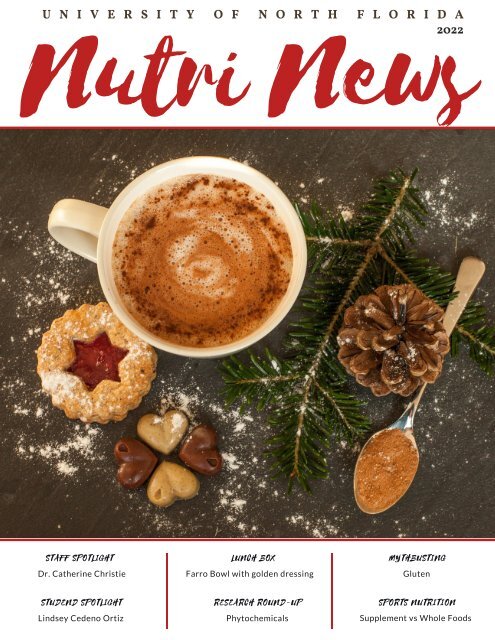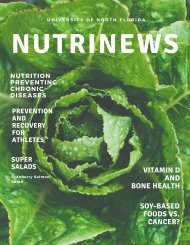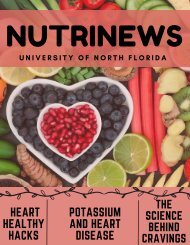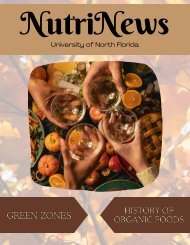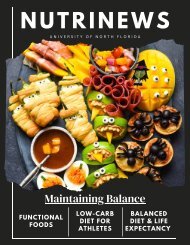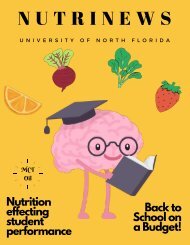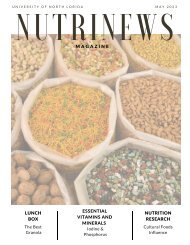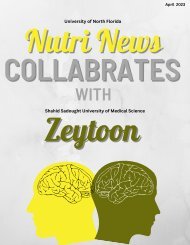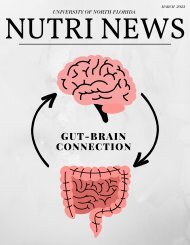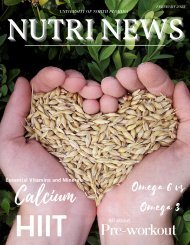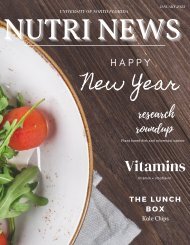Nutri News December 2022
This month theme is the colors of health!! You will find articles about: • The importance of a colorful diet “Eat the Rainbow” • How is biotechnology is affecting our foods • What is intuitive eating and how it can help you recognize and be more sensitive to your body’s hunger and satiety signals • Delicious and colorful vegan recipes in the lunch box! • What’s the hype behind Phytochemicals, are they really that important? Let me answer that for you, YESSS!! • Have you seen those foods that claim to be gluten “free” and have wonder what gluten is and if you should care whether your food is gluten free, check our myth busting article to find out more • The holidays are coming and with that all the delicious foods we like to indulge on, but beware “SALT” check out our international collaboration about salt and salt substitutes • “Ditch the dietary supplements and eat whole foods instead” What are the effects of supplement vs whole foods in sports performance • Have you been feeling tired and down recently? you might have a vitamin D deficiency, check out our essential guide to vitamins and minerals article to learn more about the role of magnesium and vitamin D in our mood, sleep, and overall health This month’s student spotlight is Lindsey Cedeno Ortiz, check what she has to say in page 12! For this month interview, we have Dr. Catherine Christie, recipient of the Academy of Nutrition and Dietetics Medallion Award. This is an interview you won’t want to miss!!!! If you are looking to make an impact on campus as well as in the community, look for the fliers highlighting volunteer opportunities. These amazing programs are always looking for more volunteers. It is amazing the difference we can make when we all work together for a better and healthier tomorrow. Happy reading!
This month theme is the colors of health!!
You will find articles about:
• The importance of a colorful diet “Eat the Rainbow”
• How is biotechnology is affecting our foods
• What is intuitive eating and how it can help you recognize and be more sensitive to your body’s hunger and satiety signals
• Delicious and colorful vegan recipes in the lunch box!
• What’s the hype behind Phytochemicals, are they really that important? Let me answer that for you, YESSS!!
• Have you seen those foods that claim to be gluten “free” and have wonder what gluten is and if you should care whether your food is gluten free, check our myth busting article to find out more
• The holidays are coming and with that all the delicious foods we like to indulge on, but beware “SALT” check out our international collaboration about salt and salt substitutes
• “Ditch the dietary supplements and eat whole foods instead” What are the effects of supplement vs whole foods in sports performance
• Have you been feeling tired and down recently? you might have a vitamin D deficiency, check out our essential guide to vitamins and minerals article to learn more about the role of magnesium and vitamin D in our mood, sleep, and overall health
This month’s student spotlight is Lindsey Cedeno Ortiz, check what she has to say in page 12!
For this month interview, we have Dr. Catherine Christie, recipient of the Academy of Nutrition and Dietetics Medallion Award. This is an interview you won’t want to miss!!!!
If you are looking to make an impact on campus as well as in the community, look for the fliers highlighting volunteer opportunities. These amazing programs are always looking for more volunteers. It is amazing the difference we can make when we all work together for a better and healthier tomorrow.
Happy reading!
You also want an ePaper? Increase the reach of your titles
YUMPU automatically turns print PDFs into web optimized ePapers that Google loves.
<strong>Nutri</strong><br />
U N I V E R S I T Y O F N<br />
<strong>News</strong><br />
O R T H F L O R I D A<br />
<strong>2022</strong><br />
STAFF SPOTLIGHT<br />
Dr. Catherine Christie<br />
LUNCH BOX<br />
Farro Bowl with golden dressing<br />
MYTHBUSTING<br />
Gluten<br />
STUDEND SPOTLIGHT<br />
Lindsey Cedeno Ortiz<br />
RESEARCH ROUND-UP<br />
Phytochemicals<br />
SPORTS NUTRITION<br />
Supplement vs Whole Foods
04.<br />
TABLE OF<br />
CONTENT<br />
YOUR ESSENTIAL GUIDE TO VITAMINS<br />
AND MINERALS<br />
Magnesium & Vitamin D<br />
07. Salt & Salt Substitutes<br />
11.<br />
INTERNATIONAL COLLABORATION<br />
MONTHLY HACKS<br />
Intuitive Eating<br />
"A healthy<br />
outside<br />
starts<br />
from the<br />
inside"<br />
Robert Urich<br />
STUDENT SPOTLIGHT<br />
12. Lindsey Cedeno Ortiz<br />
16.<br />
18.<br />
20.<br />
24.<br />
27.<br />
30.<br />
34.<br />
37.<br />
MYTHBUSTING<br />
Gluten<br />
THE LUNCH BOX<br />
Farro Bowl with Golden Dressing<br />
RESEARCH ROUND UP<br />
Phytochemicals<br />
NUTRITION SCIENCE<br />
How biotechnology is affecting our food<br />
STAFF SPOTLIGHT<br />
Dr. Christie<br />
NUTRITION RESEARCH<br />
The importance of a colorful diet<br />
SPORTS NUTRITION<br />
Supplement vs Whole Foods<br />
NUTRINEWS STAFF<br />
Follow us!<br />
@unfnutrinews
Your Essential Guide to<br />
Vitamins and Minerals<br />
Magnesium & Vitamin D<br />
By Ashley Valle<br />
Magnesium is a mineral that aids in the<br />
regulation of blood sugar levels, blood<br />
pressure, muscle and nerve function, and<br />
more.¹ Vitamin D is a vitamin that<br />
controls serum calcium levels for bone<br />
growth, prevents inflammation, and<br />
regulates phosphate.<br />
Vitamin D needs magnesium, much like<br />
iron needs vitamin C. The enzymes<br />
responsible for the metabolism of<br />
vitamin D need magnesium to work,<br />
meaning that without magnesium, our<br />
bodies cannot absorb vitamin D.³ The link<br />
between the two was discovered less<br />
than 5 years ago, extremely recently!⁴<br />
Although rare, magnesium deficiency<br />
can result in low potassium or serum<br />
calcium, seizures, fatigue, weakness, and<br />
muscle contractions.1 People more at risk<br />
for magnesium deficiency are older<br />
adults, people with Crohn’s disease,<br />
celiac, type 2 diabetes, and more.<br />
Vitamin D deficiency is more likely to<br />
occur in people who limit sun exposure,<br />
people with obesity, people with a dark<br />
complexion, and breastfed infants.²<br />
Deficiency in vitamin D can lead to<br />
osteomalacia, and rickets in children<br />
which can result in developmental delay,<br />
dental abnormalities, and more.²<br />
RDA recommendations for magnesium<br />
are 400-320mg for 19–30-year old’s and<br />
vary with different age groups, and<br />
recommendations for vitamin D are<br />
15mcg for everyone between the ages of<br />
1 year and 70 years.²<br />
4
Sources of<br />
Magnesium¹:<br />
Pumpkin seeds (37%<br />
recommended daily<br />
value)<br />
Chia seeds<br />
Almonds<br />
Spinach<br />
Cashew<br />
Sources of Vitamin D²:<br />
Cod liver oil (170%<br />
recommended daily<br />
intake!)<br />
Salmon<br />
Fortified milk (including<br />
non-dairy)<br />
Sardines<br />
Eggs<br />
References:<br />
1. Office of dietary supplements -<br />
magnesium. NIH Office of Dietary<br />
Supplements.<br />
https://ods.od.nih.gov/factsheets/Magnesi<br />
um-Consumer/. Accessed November 10,<br />
<strong>2022</strong>.<br />
2. Office of dietary supplements - vitamin D.<br />
NIH Office of Dietary Supplements.<br />
https://ods.od.nih.gov/factsheets/VitaminD<br />
-Consumer/. Accessed November 10, <strong>2022</strong>.<br />
3. Uwitonze AM, Razzaque MS. Role of<br />
Magnesium in Vitamin D Activation and<br />
Function. J Am Osteopath Assoc.<br />
2018;118(3):181-189. doi:10.7556/jaoa.2018.037<br />
4. Curley B. Vitamin D and magnesium<br />
levels. Healthline.<br />
https://www.healthline.com/healthnews/how-magnesium-can-help-yourvitamin-dlevels#:~:text=The%20study%2C%20publish<br />
ed%20in%20the,role%20in%20vitamin%20D%<br />
20regulation. Published January 5, 2019.<br />
Accessed November 10, <strong>2022</strong><br />
5
N U T R I N E W S<br />
M A G A Z I N E<br />
S E I Z E<br />
T H E<br />
D A Y &<br />
V O L U N T E E R<br />
P O S I T I O N S A V A I L A B L E<br />
<br />
E D I T O R S<br />
W R I T E R S<br />
P U B L I C R E L A T I O N S W E B S I T E M A N A G E R<br />
<br />
<br />
C O N T A C T S A I L Y M E D E R O<br />
N 0 1 4 4 0 5 5 6 @ U N F . E D U
INTERNATIONAL COLLABRATION<br />
Doctorado en Ciencias de la <strong>Nutri</strong>ción Traslacional, Centro Universitario de Ciencias de la Salud<br />
(CUCS), Universidad de Guadalajara (UdeG), Guadalajara 44320, Mexico<br />
S A L T A N D S A L T<br />
S U B S T I T U T E S , W H A T I S<br />
T H E I R I M P L I C A T I O N I N<br />
H E A L T H ?<br />
Introduction<br />
L N . D A N I E L A V Á Z Q U E Z R O D R Í G U E Z<br />
<br />
Sodium is a necessary mineral for our body, it helps to maintain adequate blood volume and<br />
blood pressure. One of the ways in which we obtain this mineral is through the intake of salt,<br />
which is composed of sodium and chlorine in 40 and 60 percent respectively1. The salt<br />
ingested can come from both processed foods or add during food preparation.<br />
The World Health Organization (WHO) recommends a maximum salt intake of 5 grams per<br />
day. However it is estimated that the average intake of salt in adults is almost triple at 14<br />
grams2, also it has been observed that excessive consumption of salt can be a risk factor for<br />
high blood pressure, heart failure, chronic kidney disease and cardiovascular diseases1.<br />
Usual nutritional interventions to reduce sodium intake<br />
The restriction of salt intake is one of the most widespread strategies for the management of<br />
arterial hypertension where a decrease in blood pressure has been seen, where a decrease of<br />
4.9% in SBP (Systolic blood pressure) and 3.3% in DBP (Diastolic blood pressure) has been<br />
found,3 in addition It has been reported that with a reduction in salt consumption of 4.4 g<br />
per day for more than 4 weeks, an average decrease of 5.4 mmHg of SBP and 2.8 mmHg of<br />
DBP in people with hypertension, while in people without hypertension, it decreases<br />
2.mmHg of SBP and 1 mmHg of DBP.4<br />
7
INTERNATIONAL COLLABRATION<br />
Another type of nutritional intervention for reducing sodium intake is the DASH diet, which is<br />
rich in whole grains, fruits, vegetables, polyunsaturated fats, and low-fat dairy products, and is<br />
low in sodium, foods high in sugar, saturated fat, and trans fat that together they favor the<br />
management of blood pressure with a decrease in SBP of less than 7 mmHg in people<br />
without hypertension and 11 mmHg in patients with hypertension.5,6 In another study in<br />
which the DASH diet has been applied together with a decrease in the amount of salt in the<br />
diet, a decrease in SBP of 4.6 mmHg and DBP blood of 2.6 mmHg was obtained, in addition to<br />
finding changes in body fat content and BMI.7<br />
What is a salt substitute?<br />
Other strategies that have been implemented to reduce sodium consumption range from the<br />
reformulation of industrialized products, educational campaigns to the population and the<br />
use of salt substitutes, the latter offering the possibility of reducing sodium consumption<br />
without affecting the taste. In these products sodium is replaced by other minerals such as<br />
potassium chloride; It should be noted that the term "salt substitute" is regulated and it is<br />
established that the sodium content will not be greater than 120 mg per 100g of product.8.<br />
Salt substitute and blood pressure<br />
Regarding the evidence regarding the use of salt substitutes, studies have been carried out<br />
with various approaches from their effect on blood pressure, mortality and relationship with<br />
cardiovascular disease and stroke in population between 50 and 70 years, with and without<br />
high blood pressure, the most of these studies have been conducted in China, India and Peru.<br />
The effects on blood pressure that have been observed since the 8 weeks of intervention with<br />
a salt substitute with 35% potassium chloride, in patients with hypertension, a decrease in SBP<br />
of 11.4 mmHg was reported.9 Likewise, other studies using a substitute with 25% potassium<br />
chloride after 3 months had a favorable effect on blood pressure with a reduction of 4 mmHg<br />
in SBP and 1 mmHg in DBP.10<br />
A study with a salt substitute in which more participants had with a total of 2376 with and<br />
without hypertension, with a duration of 5 months had a decrease of 2.17 mmHg in SBP and<br />
1.18 mmHg in DBP in those with ≥60 years.11<br />
Finally, in a more recent study in people aged between 50 and 70 years, with a follow-up of<br />
more than 12 months, it was found that the effect on blood pressure of a decrease in SBP of 6.6<br />
mmHg and 1.8 mmHg of DBP.12<br />
8
Salt substitute and Mortality<br />
Regarding the effects on mortality,<br />
results have been found in favor of<br />
the use of salt substitutes, in a<br />
study in which they were followed<br />
for 10 years and found that salt<br />
substitute consumption was<br />
associated with a lower risk of<br />
stroke in both patients with and<br />
without hypertension.13<br />
Similar results were observed in an intervention with salt substitute vs salt with a total<br />
population of 20,995 people with hypertension over 60 years of age. They were followed up for<br />
5 years, finding a lower stroke rate in the salt substitute group as well as a lower frequency of<br />
death due to vascular causes and acute myocardial infarction.14<br />
Security<br />
Regarding the safety of the consumption of salt substitutes, there is not enough evidence on<br />
the effects of potassium-enriched salt substitutes on the development of hyperkalemia<br />
(elevation of potassium in the blood), however, it is important to consider that in certain<br />
conditions if there could be a risk of hyperkalemia, as is the case with people with Chronic<br />
kidney disease or taking medications that alter potassium excretion.15,16<br />
What about Himalayan salt?<br />
In addition to salt substitutes, in recent years the consumption of Himalayan salt has been<br />
given the "healthy" label for its low sodium content and content of other minerals such as<br />
magnesium, calcium, zinc, potassium, iron among others. However there is very little scientific<br />
evidence in which it has been found that exerts no effect on blood pressure, urinary sodium<br />
excretion, in addition to amounts of sodium are similar to traditional table salt, therefore its<br />
only difference regarding table salt is its cost.17<br />
9
Conclusions<br />
For all of the above, salt substitutes have positive effects on health; decreasing blood pressure<br />
and risk of stroke; However, more research is needed to evaluate its consumption in people at<br />
risk of hyperkalemia.<br />
·The use of salt substitutes can be a public health tool to reduce excessive consumption of<br />
sodium as well as high blood pressure.<br />
·It is important to consider other strategies such as education and nutritional counseling to<br />
reduce excessive consumption of sodium and consequently the risks that it entails.<br />
A salt substitute contains less than 120 mg of sodium per 100 g of product.<br />
References<br />
1. Patel Y, Joseph J. Sodium Intake and Heart Failure. IJMS. 2020;21(24):9474. doi:10.3390/ijms21249474<br />
2. Bhat S, Marklund M, Henry ME, et al. A Systematic Review of the Sources of Dietary Salt Around the World. Advances in <strong>Nutri</strong>tion.<br />
2020;11(3):677-686. doi:10.1093/advances/nmz134<br />
3. D’Elia L, La Fata E, Giaquinto A, Strazzullo P, Galletti F. Effect of dietary salt restriction on central blood pressure: A systematic review and<br />
meta‐analysis of the intervention studies. J Clin Hypertens. 2020;22(5):814-825. doi:10.1111/jch.13852<br />
4. Graudal NA, Hubeck-Graudal T, Jurgens G. Effects of low sodium diet versus high sodium diet on blood pressure, renin, aldosterone,<br />
catecholamines, cholesterol, and triglyceride. Cochrane Hypertension Group, ed. Cochrane Database of Systematic Reviews. 2020;2021(8).<br />
doi:10.1002/14651858.CD004022.pub5<br />
5. Unger T, Borghi C, Charchar F, et al. 2020 International Society of Hypertension Global Hypertension Practice Guidelines. Hypertension.<br />
2020;75(6):1334-1357. doi:10.1161/HYPERTENSIONAHA.120.15026<br />
6. Sacks FM, Svetkey LP, Vollmer WM, et al. Effects on Blood Pressure of Reduced Dietary Sodium and the Dietary Approaches to Stop<br />
Hypertension (DASH) Diet. N Engl J Med. 2001;344(1):3-10. doi:10.1056/NEJM200101043440101<br />
7. Kucharska A, Gajewska D, Kiedrowski M, et al. The impact of individualized nutritional therapy according to DASH diet on blood pressure,<br />
body mass, and selected biochemical parameters in overweight/obese patients with primary arterial hypertension: a prospective<br />
randomized study. Kardiol Pol. 2018;76(1):158-165. doi:10.5603/KP.a2017.0184<br />
8. Farrand C, MacGregor G, Campbell NRC, Webster J. Potential use of salt substitutes to reduce blood pressure. J Clin Hypertens.<br />
2019;21(3):350-354. doi:10.1111/jch.13482<br />
9. Liu T, Rao H, Wang M, et al. Comparative analysis of visit and home blood pressure in a pilot trial on the effect of 18% sodium substitute<br />
salt on blood pressure. Sci Rep. 2021;11(1):907. doi:10.1038/s41598-020-79282-2<br />
10. Yu J, Thout SR, Li Q, et al. Effects of a reduced-sodium added-potassium salt substitute on blood pressure in rural Indian hypertensive<br />
patients: a randomized, double-blind, controlled trial. The American Journal of Clinical <strong>Nutri</strong>tion. 2021;114(1):185-193.<br />
doi:10.1093/ajcn/nqab054<br />
11. Bernabe-Ortiz A, Sal y Rosas VG, Ponce-Lucero V, et al. Effect of salt substitution on community-wide blood pressure and hypertension<br />
incidence. Nat Med. 2020;26(3):374-378. doi:10.1038/s41591-020-0754-2<br />
12. Che L, Song W, Zhang Y, Lu Y, Cheng Y, Jiang Y. A randomized, double‐blind clinical trial to evaluate the blood pressure lowing effect of<br />
low‐sodium salt substitution on middle‐aged and elderly hypertensive patients with different plasma renin concentrations. J of Clinical<br />
Hypertension. <strong>2022</strong>;24(2):140-147. doi:10.1111/jch.14396<br />
13. Sun H, Ma B, Wu X, Wang H, Zhou B. Long-Term Effect of Salt Substitute on All-Cause and Cardiovascular Disease Mortality: An<br />
Exploratory Follow-Up of a Randomized Controlled Trial. Front Cardiovasc Med. 2021;8:645902. doi:10.3389/fcvm.2021.645902<br />
14. Neal B, Wu Y, Feng X, et al. Effect of Salt Substitution on Cardiovascular Events and Death. N Engl J Med. 2021;385(12):1067-1077.<br />
doi:10.1056/NEJMoa2105675<br />
15. Ajenikoko A, Ide N, Shivashankar R, et al. Core Strategies to Increase the Uptake and Use of Potassium-Enriched Low-Sodium Salt.<br />
<strong>Nutri</strong>ents. 2021;13(9):3203. doi:10.3390/nu13093203<br />
16. Greer RC, Marklund M, Anderson CAM, et al. Potassium-Enriched Salt Substitutes as a Means to Lower Blood Pressure: Benefits and<br />
Risks. Hypertension. 2020;75(2):266-274. doi:10.1161/HYPERTENSIONAHA.119.13241<br />
17. Loyola IP, Sousa MF de, Jardim TV, et al. Comparação entre os Efeitos da Ingestão de Sal do Himalaia e de Sal Comum sobre os Valores<br />
de Sódio Urinário e Pressão Arterial em Indivíduos Hipertensos. Arquivos Brasileiros de Cardiologia. Published online <strong>December</strong> 8, 2021.<br />
doi:10.36660/abc.20210069<br />
10
Written By: Sophia Harris<br />
The Practice<br />
of Intuitive Eating<br />
As early as the 1900s, fad diets of all kinds<br />
have been followed by many people to lose<br />
weight in pursuit of health1. But in more<br />
recent days, more people are realizing that<br />
these crash diets are not improving their<br />
health but are doing the opposite. More<br />
people are finding varying ways to improve<br />
or maintain their health. One of these latest<br />
ideas is intuitive eating.<br />
What exactly is intuitive eating? The idea of<br />
intuitive eating is to be more conscious of<br />
your hunger cues or when you are satisfied2,<br />
rather than adhering to the strict and<br />
restrictive rules of dieting. Listening to your<br />
body can help prevent overeating or<br />
undereating3. The implementation of<br />
intuitive eating combined with the knowledge<br />
of healthy food options can help both<br />
maintain healthy weight and improve overall<br />
health3.<br />
Recognizing hunger and satiety is an<br />
important aspect of intuitive eating aside<br />
from picking healthier foods3. It is important<br />
to recognize hunger as soon as possible,<br />
waiting too long can lead to overeating which<br />
makes detecting satiety difficult3. Early<br />
indications of hunger are difficulty<br />
concentrating, decreased energy, rumbling<br />
stomach, or the stomach feeling empty3.<br />
Symptoms of late hunger are fatigue,<br />
lightheadedness, headache,<br />
intense sense of smell, increased production<br />
of saliva, and an overpowering need to eat3<br />
Eating slowly is crucial in recognizing<br />
satiety3, as well as knowing the difference<br />
between fullness and satisfaction. When you<br />
are full, your body tells you that you<br />
physically cannot eat anymore while feeling<br />
satisfied is more of a feeling of comfort and<br />
fulfillment3.<br />
Another tip when practicing intuitive eating<br />
is to pick foods that are not only nutritious<br />
but also taste good4. Intuitive eating is not<br />
about eating a limited selection of foods that<br />
you may not like, as seen in typical diets. It is<br />
all about consuming nutritious food that you<br />
enjoy4,everyone has different preferences<br />
so pick items that you enjoy eating.<br />
One final but vital tip to practice intuitive<br />
eating is to be kind to yourself5. Intuitive<br />
eating is not about losing weight, it is about<br />
focusing on what you feel is best for you4.<br />
Everyone is different, and no one practicing<br />
this lifestyle is going to eat the same. All that<br />
matters is that you choose food that feels<br />
enjoyable and comfortable to you. There is<br />
no food that is inherently good or bad, what<br />
is important is balance and a wide variety of<br />
foods. Remember not to be hard on yourself<br />
and to focus on what makes you happy and<br />
healthy.<br />
Resources<br />
1.Rowan T. Diet Culture: A Brief History. Social and Health Research Center Inc website. April 21, <strong>2022</strong>. https://sahrc.org/<strong>2022</strong>/04/diet-culture-a-briefhistory/#:~:text=It%20wasn't%20until%20the,were%20in%20season%20and%20available<br />
2.Turner R. What is Intuitive Eating? A <strong>Nutri</strong>tionist Explains. Cedars-Sinai Blog. March 8, 2021. https://www.cedars-sinai.org/blog/what-is-intuitive-eating.html<br />
3.University Hospitals. What is Intuitive Eating and How It Can Help You Eat Right. September 12, 2021. https://www.uhhospitals.org/Healthy-at-UH/articles/2021/09/what-is-intuitive-eating-and-how-it-can-helpyou-eat-right<br />
4.Cleveland Clinic. The Benefits of Intuitive Eating vs. Dieting. <strong>News</strong>room Resources for journalists and media outlets website. August 8, <strong>2022</strong>. https://newsroom.clevelandclinic.org/<strong>2022</strong>/08/08/the-benefits-ofintuitive-eating-vs-dieting/<br />
5.The Original Intuitive Eating Pros. 10 Principles of Intuitive Eating. The Original Intuitive Eating Pros Blog. N.d. http://www.intuitiveeating.org/10-principles-of-intuitive-eating/ 11
L I N D S E Y C E D E N O O R T I Z<br />
S T U D E N T<br />
S P O T L I G H T<br />
What inspired you to pursue your degree?<br />
I’ve always enjoyed food—I wanted to be a pastry chef when I was younger. But<br />
when I got older, I realized there was so much misinformation on what exactly I<br />
should be eating. I also didn’t know what I wanted to major in when I graduated<br />
high school, until I realized Dietetics was the perfect mix of the two things I<br />
love: science and food. Once I realized that Dietetics is what I wanted to do,<br />
everything kind of fell into place. I could apply what I learned to living a<br />
healthier life, to weightlifting, and to eventually working in healthcare. I figured,<br />
if I became educated on nutrition, I could weed out all the misinformation and<br />
help others do the same.<br />
12
What activities or hobbies do you enjoy<br />
doing outside of school?<br />
If I’m not studying or volunteering, I am<br />
definitely at the gym. I do Olympic lifting<br />
through the UNF Weightlifting club, and I<br />
love it. Since moving to Jacksonville, lifting is<br />
the one thing that’s kept me grounded and<br />
helped take some of the stress off school. I<br />
can go there and just have fun and challenge<br />
myself in a way that’s not academic. I also lift<br />
with the kindest, funniest people ever, so<br />
that’s a plus.<br />
What has been most challenging to you<br />
since beginning your program here at<br />
UNF?<br />
Managing my stress. I want to do everything<br />
perfectly all the time and I end up<br />
overthinking and freaking out. I’ve found it’s<br />
gotten easier, though, to just chill out and<br />
trust myself. I have a lot of support from the<br />
people around me as well, so I just lean on<br />
them when I need some extra help.<br />
What advice would you give to incoming<br />
students entering the UNF?<br />
Try everything! Take every opportunity. Join<br />
every club, go to every meeting, talk to every<br />
person and professor! College is such a<br />
unique setting where we just have so many<br />
different opportunities available to us, and<br />
I’ve found that getting out of my comfort<br />
zone and taking advantage of these things<br />
has helped me tremendously. You’ll find the<br />
best friends and mentors if you just reach out<br />
and try different things.<br />
13
What has been your favorite class in<br />
the <strong>Nutri</strong>tion and Dietetics Program?<br />
This is so hard because I really have liked<br />
all my classes and I love all my professors!<br />
I got a lot out of Lifespan <strong>Nutri</strong>tion and<br />
Sports <strong>Nutri</strong>tion, and I have a love-hate<br />
relationship with Medical <strong>Nutri</strong>tion<br />
Therapy right now. I also loved bioorganic<br />
chemistry and studying abroad!<br />
What plans and goals do you have<br />
after graduation?<br />
I’m going to complete my internship and<br />
my masters and pass the RD exam! My<br />
goals is to work in a Pediatric hospital as<br />
an RD, so I’d love to become a Board-<br />
Certified specialist in Pediatric <strong>Nutri</strong>tion<br />
and maybe even Sports Dietetics.<br />
Do you have a favorite inspiring quote<br />
or mantra that you live by and would<br />
like to share with others?<br />
My mom always tells me “If other people<br />
have done it, why can’t you?” That always<br />
helps me get out of my head and realize<br />
that I’m totally capable of anything I set<br />
my mind to.<br />
Short answer Qs:<br />
Favorite color? Pink and black<br />
Favorite food? Sushi, chocolate, and<br />
coffee<br />
Favorite book? Tiny Beautiful Things by<br />
Cheryl Strayed<br />
Favorite pastime? Weightlifting and<br />
listening to music<br />
Biggest fear? …frogs…<br />
Greatest motivation? My parents<br />
14
MYTH BUSTING:<br />
GLUTEN<br />
By Dahnine<br />
McCune-<br />
Moyer<br />
Gluten is more complicated than you think it<br />
is, that is because gluten is not just one<br />
protein. It is a mixture of seed proteins; the<br />
exact mixture depends on the source of the<br />
gluten. Gluten is found in wheat, barley, rye,<br />
and oats. The gluten found in all these<br />
proteins is different from each other, this<br />
means they will react differently in the<br />
human digestive tract. Wheat gluten tends<br />
to be the most reactive of all these proteins.<br />
Gluten gives the chewiness of the bagel or<br />
baked good you are eating. The proteins<br />
that cause this are gliadin and glutenin, they<br />
give bread its stretchy texture. This is what<br />
you perceive when you chew the bread.<br />
Once you chew a bagel, a digestive enzyme<br />
called pepsin (a type of protease) in your<br />
stomach is designed to break down proteins.<br />
It is a common misconception that gluten<br />
cannot be broken down inside the stomach.<br />
Gluten does get digested in the stomach,<br />
just not fully. Pepsin breaks down the gluten<br />
into the seed storge proteins gliadin and<br />
glutenin. Remember, proteins are very large<br />
structures and need to be broken down into<br />
amino acids. That is exactly what this<br />
protease does, it breaks it down into gliadin<br />
and glutenin then moves into the small<br />
intestine.<br />
Now the bagel is in the small intestines. The<br />
protases of the small intestines are going to<br />
descend upon the gliadin and glutenin and<br />
create these amino acid fragments. If<br />
fragments of the gliadin protein are too big<br />
to digest in the small intestines, they can<br />
invade the intestinal tissue and trigger an<br />
autoimmune response which can bring a<br />
rush of white blood cells to the area which<br />
cause inflammation, otherwise known as<br />
celiac disease.<br />
16
For most people gliadin and glutenin get<br />
passed through the small intestines and on<br />
to the large intestines and then are<br />
excreted. However, the gliadin fragments<br />
can sneak into the intestinal wall with celiac<br />
disease, the exact reason behind this is a hot<br />
debate in nutritional sciences. Celiac<br />
disease is a relatively rare disease affecting<br />
about 2 million Americans.<br />
A wheat allergy is far simpler than celiac<br />
disease because a wheat allergy is a food<br />
allergy3. If you have heard of other food<br />
allergies, you may understand what is going<br />
on with a wheat allergy. In this instance<br />
though, it is not just one protein that is the<br />
problem, it is many different wheat proteins.<br />
So, with celiac it is gliadin but with a wheat<br />
allergy it is an allergy to many different<br />
wheat proteins. A wheat allergy<br />
predominately affects children, and<br />
fortunately they tend to outgrow it.<br />
In an allergic reaction, antibodies bind to the<br />
proteins that initiate a white blood cell<br />
reaction and can be severe enough to cause<br />
anaphylaxis. Anaphylaxis is a severe allergic<br />
reaction and can be fatal if not properly<br />
treated.<br />
Non celiac gluten sensitivity is<br />
characterized by the absence of a gluten<br />
allergy or celiac disease but still consists of<br />
symptoms such as bloating or general<br />
discomfort. It is a controversial topic due to<br />
the absence of a test that will show that<br />
there is a problem with the digestion of<br />
gluten. That is not the case for celiac and<br />
wheat allergy, these two have testing that<br />
shows a definite positive or negative<br />
diagnosis.<br />
on your standard western diet. What do<br />
your sleep and exercise habits look like? Are<br />
you eating fruits, vegetables, and legumes?<br />
What is your microbiota like? When was the<br />
last time you took broad-spectrum<br />
antibiotics? Does there needs to be an<br />
overhaul on your general health? If your gut<br />
isn’t healthy, you may have these<br />
intolerances. We need to look at our overall<br />
lifestyle4. That includes diet, sleeping<br />
patterns, and excess alcohol.<br />
References:<br />
1. Palmieri B, Vadala' M, Laurino C. Gluten-free diet in non-celiac<br />
patients: beliefs, truths, advantages and disadvantages.<br />
Minerva Gastroenterol Dietol. 2019;65(2):153-162.<br />
doi:10.23736/S1121-421X.18.02519-9<br />
2. https://www.hopkinsmedicine.org/health/conditions-and-<br />
diseases/celiac-<br />
disease#:~:text=Celiac%20disease%20is%20genetic.,133%20<br />
Americans%20may%20have%20it. Accessed 10/31/<strong>2022</strong><br />
3. Roszkowska A, Pawlicka M, Mroczek A, Bałabuszek K,<br />
Nieradko-Iwanicka B. Non-Celiac Gluten Sensitivity: A<br />
Review. Medicina (Kaunas). 2019;55(6):222. Published 2019<br />
May 28. doi:10.3390/medicina55060222<br />
4. Jønsson IM, Møller GL, Pærregaard A. Ugeskr Laeger.<br />
2017;179(22):V09160636.<br />
Bigger problems play a bigger role, and<br />
gluten is just along for the ride. We need to<br />
ask what the overall state of health is based<br />
17
L U N C H B O X : G O G R E E N<br />
V E G A N F A R R O B O W L W I T H<br />
G O L D E N D R E S S I N G<br />
Inspiration: @kitkeenan on Instagram<br />
By. Kate Overby<br />
This Vegan Farro Bowl is a simple and delicious option for a pop of green in your<br />
lunch or dinner meal plans. Add grilled chicken for some extra protein or to satisfy<br />
your non-vegan friends and family members.<br />
18<br />
Ingredients:<br />
2 cups brussel sprouts (chopped in halves)<br />
1 can chickpeas (drained)<br />
1 large zucchini (sliced)<br />
3 tbsp olive oil<br />
2 tbsp maple syrup<br />
2 tbsp garlic powder<br />
2 tbsp oregano (fresh is best!)<br />
1 tbsp onion salt<br />
1 cup farro<br />
Lemon<br />
1/3 cup tahini<br />
Salt and pepper
Instructions:<br />
1. Preheat oven to 425<br />
2. Add brussels, chickpeas, and<br />
zucchini to a large bowl<br />
3. Mix veggies with 2 tbsp olive oil, 1<br />
tbsp maple syrup, 1 tbsp garlic<br />
powder, 2 tbsp oregano, and 1<br />
tbsp onion salt and spread<br />
evenly onto a sheet pan<br />
4. Bake veggies for 20-30 minutes<br />
5. While veggies are in the oven,<br />
cook 1 cup of farro according to<br />
package<br />
6. Add freshly chopped parsley, 1<br />
tbsp olive oil, and the juice from<br />
½ a lemon to the farro. Mix<br />
gently<br />
7. Make a yummy sauce by<br />
combining 1/3 cup tahini, the<br />
juice from the remaining ½<br />
lemon, 1 tbsp maple syrup, 1 tbsp<br />
garlic powder, salt and pepper to<br />
taste, and about 2 tbsp water to<br />
thin the sauce to your desired<br />
consistency<br />
8. Top farro with roasted veggies<br />
and a drizzle of Kit Keenan’s<br />
“Golden Dressing”!<br />
19
Written by:<br />
Alicia Scott<br />
CAN PHYTOCHEMICALS BE IMPORTANT<br />
IN THE DIET?<br />
Phytochemicals are nonnutritive, plantbased<br />
bioactive components that have<br />
certain disease-preventing properties.¹<br />
Some foods that contain phytochemicals<br />
include whole grains, fruits, vegetables,<br />
and nuts. These phytochemical<br />
properties have been proven to be<br />
beneficial for overall health.<br />
Phytochemicals impact health by being<br />
antioxidants that can act as antifungal,<br />
anti-inflammatory, antibacterial,<br />
hypolipidemic, and hypotensive agents.¹<br />
Recent research has been conducted to<br />
review the phytochemical and metabolic<br />
benefits of lettuce.<br />
Lettuce is one of the most diverse leafy<br />
vegetables, and the diversity is spread<br />
across the lettuce family. Let’s take a<br />
look at the importance of the<br />
phytochemicals in lettuce.<br />
20
Most phytochemicals that are found in<br />
lettuce include vitamin B9 (folate),<br />
vitamin C, vitamin E, carotenoids, and<br />
polyphenols.² There are several<br />
biological functions that vitamin C<br />
exerts, one being that ascorbic acid<br />
contributes to 24.5% of the antioxidant<br />
activity in lettuce.² The level of vitamin C<br />
in lettuce, however, is not as high as the<br />
level of folate. Folate is higher in<br />
romaine lettuce than it is in spinach.³<br />
This might be surprising to some, but<br />
when looking up foods that are rich in<br />
folate, romaine lettuce is often one of the<br />
top foods listed. The health benefits of<br />
lettuce are tied to its phytochemicals and<br />
antioxidant properties. The<br />
phytochemicals have a cardio-protective<br />
effect, which means that they have a<br />
positive impact on cardiovascular<br />
disease (CVD). The antioxidant properties<br />
have been shown to improve cholesterol<br />
metabolism and aid in the prevention of<br />
CVD.⁴ There is also an anti-cancer effect,<br />
as the phytochemicals have a positive<br />
impact on cancer prevention. This anticancer<br />
effect is due to the fact that<br />
iodine-biofortified lettuce can cause<br />
cancer cells to produce more reactive<br />
oxygen species and undergo apoptosis.⁵<br />
References<br />
1. Thakur M, Singh K, Khedkar R. Phytochemicals: Extraction<br />
Process, safety assessment, toxicological evaluations, and<br />
regulatory issues. Functional and Preservative Properties of<br />
Phytochemicals.<br />
https://www.sciencedirect.com/science/article/pii/B978012818<br />
5933000117. Published February 21, 2020. Accessed<br />
November 1, <strong>2022</strong>.<br />
2. Lafarga T, Villaró S, Rivera A, Bobo G, Aguiló-Aguayo I.<br />
Bioaccessibility of polyphenols and antioxidant capacity of<br />
fresh or minimally processed modern or traditional lettuce<br />
(Lactuca sativa L.) varieties. J. Food Sci. Technol.<br />
2019;57(2):754-763. doi:10.1007/s13197-019-04108-7<br />
3. Wang C, Riedl KM, Schwartz SJ. Fate of folates during<br />
vegetable juice processing — deglutamylation and<br />
interconversion. Food Res. Int. 2013;53(1):440-448.<br />
doi:10.1016/j.foodres.2013.05.011<br />
4. Shi M, Gu J, Wu H, et al. Phytochemicals, nutrition,<br />
metabolism, bioavailability, and health benefits in lettuce—a<br />
comprehensive review. Antioxidants. <strong>2022</strong>;11(6):1158.<br />
doi:10.3390/antiox11061158<br />
5. Sularz O, Koronowicz A, Smoleń S, et al. Anti- and prooxidant<br />
potential of lettuce (lactuca sativa L.) biofortified with<br />
iodine by KIO3, 5-iodo- and 3,5-diiodosalicylic acid in human<br />
gastrointestinal cancer cell lines. RSC Advances.<br />
2021;11(44):27547-27560. doi:10.1039/d1ra04679a<br />
21
Volunteers needed<br />
Give back to your community by preparing nutritious meals for<br />
seniors at the UNF Center for <strong>Nutri</strong>tion and Food Security. Interested?<br />
Send your N# to cnfs@unf.edu
Disability is<br />
not inability.<br />
D E C E M B E R 3 R D<br />
INTERNATIONAL<br />
DAY<br />
Of Persons with Disabilities
How is Biotechnology Affecting<br />
Our Food?<br />
Written By: Isabelle Brazelton<br />
What is Biotechnology?<br />
“Biotechnology” or “agricultural<br />
biotechnology” is a set of methods and<br />
mechanisms that alter living organisms in an<br />
effort to modify a product (e.g. plants) or<br />
create a new product (e.g. microorganisms).1<br />
These modifications are done in various ways<br />
to improve both the quality and quantity of<br />
different foods and crops, increasing the<br />
nutrition, flavor, texture, and profit of many<br />
different foods. Some familiar references to<br />
biotechnology’s work are genetically modified<br />
organisms, or GMOs, which have become the<br />
source of much controversy over the years.<br />
But why is this?<br />
What are the Benefits of<br />
Biotechnology?<br />
Biotechnology has proven to be very<br />
beneficial for both farmers and producers,<br />
as well as consumers; this is the case for<br />
several reasons. Not only has biotechnology<br />
made the management of weeds, pests, and<br />
crop disease both safer and easier, but it can<br />
also help to produce larger, tastier, and<br />
higher-quality crop yields.1,2 Additionally,<br />
the United States Department of Agriculture<br />
(USDA), Environmental Protection Agency<br />
(EPA), nd Food and Drug Administration<br />
(FDA) all operate to make sure that<br />
genetically engineered crops are thoroughly<br />
monitored and tested to verify that they do<br />
not present a significant risk to either<br />
consumers or the environment.1<br />
24<br />
Increased Crop Yield<br />
By modifying crops to increase their resistance<br />
to disease and drought, there is significantly<br />
less crop loss to these potentially devastating<br />
occurrences.2 Similarly, some crops are<br />
modified to produce specific proteins that can<br />
kill insects when they try to consume them,<br />
which also prevents crop loss. This ability to<br />
fight against crop loss and increase overall<br />
yield can lead to both reduced cost of produce<br />
for consumers and also higher profit for<br />
farmers and producers. Additionally, some<br />
produce can be modified to stay fresh for<br />
longer after being harvested, allowing<br />
consumers to have better access to fresher,<br />
more flavorful, and more nutritious foods.<br />
Improved <strong>Nutri</strong>tion and Flavor<br />
The nutritional profile of some foods can even<br />
be enhanced through biotechnology; this<br />
includes things such as increased protein<br />
content, better bioavailability, improved amino<br />
acid content, and the integration of new<br />
elements such as beta-carotene (a pigment<br />
beneficial in helping prevent blindness in<br />
populations with nutritionally poor diets).2<br />
While the implementation of these<br />
enhancements is dependent on the type of<br />
food in question, they show great promise for<br />
increasing nutrient density in many various<br />
crops. In addition, by modifying various<br />
plantenzymes, the flavor of some foods may
e enhanced making the consumption of<br />
these foods more enjoyable and appealing<br />
overall.<br />
Reduced Pesticide Usage<br />
By modifying crops to be less dependent on<br />
pesticides, there are less pesticide residues<br />
both on foods and leached into groundwater.2<br />
For reference, the development of pestresistant<br />
cotton has already reduced the<br />
world’s insecticide use by over 15%. This<br />
reduction in pesticide use is better and safer<br />
for both consumers and the environment.<br />
What are the Concerns of<br />
Biotechnology?<br />
Concerns about the use of biotechnology<br />
and GMOs come from both consumers and<br />
environmentalists who feel that there has<br />
not been enough effort done to understand<br />
potential dangers and long-term impacts.2<br />
Additionally, there is much fear that has<br />
risen out of both lack of information and<br />
misinformation, centering around concerns<br />
for both personal and planetary health.<br />
Overall, however, there is minimal scientific<br />
evidence that supports biotechnology as a<br />
major risk to population health or the<br />
environment.<br />
Health-related Concerns<br />
Some health-related concerns about the use<br />
of agricultural biotechnology include the<br />
introduction of new allergens and antibiotic<br />
resistance.2 Due to the modification of the<br />
nutritional profile of some foods, a<br />
prominent fear is that new allergens will be<br />
introduced into previously safe foods, or<br />
that existing allergens with be enhanced.<br />
Currently, there is not much evidence to<br />
support this fear. In fact, the FDA monitors and<br />
ensures that levels of naturally occurring<br />
allergens are not increased in GMO foods, and,<br />
furthermore, biotechnology is actually being<br />
developed to try and remove deadly allergens<br />
from foods such as peanuts and make them<br />
safer. The development of antibiotic-resistant<br />
bacteria is also a very serious and prominent<br />
concern. It is feared that antibiotic-resistance<br />
genes used in the production of GMOs will<br />
result in reduced effectiveness of some<br />
antibiotics against diseases. To combat this<br />
concern, the FDA has advised that techniques<br />
involving antibiotic-resistant biomarkers linked<br />
to clinically important antibiotics be avoided.<br />
Environment-related Concerns<br />
Some environment-related concerns about the<br />
use of agricultural biotechnology include the<br />
creation of “superweeds,” development of<br />
insecticide resistance, loss of biodiversity, and<br />
overall unforeseen impacts.2 To start, it is<br />
feared that cross-pollination with related<br />
weeds will result in uncontrollable superweeds;<br />
this is not inconceivable, but the possibility is<br />
very small. These superweeds, however, would<br />
not be immune to all herbicides, and thus<br />
would still be able to be controlled. Similarly, it<br />
is feared that insects could develop insecticide<br />
resistance through the consumption of GMO<br />
crops that have been altered to repel certain<br />
insects. While this is a realistic concern, so far,<br />
there have not been any instances of this<br />
occurring. Lastly, there is concern that<br />
biotechnology will give way to a loss of<br />
biodiversity in the natural environment. To<br />
combat this concern, it has become<br />
increasingly important to collect and store<br />
various plant seeds and preserve their genetic<br />
material to maintain a pool of genetic diversity<br />
for the crops of the future.<br />
Resources<br />
1. Biotechnology faqs. USDA. https://www.usda.gov/topics/biotechnology/biotechnology-frequently-asked-questions-faqs. Accessed October 27, <strong>2022</strong>.<br />
2. Wieczorek, A. (2003) Use of Biotechnology in Agriculture—Benefits and Risks.<br />
http://www.ctahr.hawaii.edu/oc/freepubs/pdf/BIO-3.pdf<br />
25
International<br />
Volunteer Day<br />
<strong>December</strong> 5th<br />
W H E R E C A N Y O U V O L U N T E E R ?
Dr. Catherine Christie<br />
Welcome back Dr. Christie!, tell us what have<br />
you been working on since our last interview?<br />
Currently, as the Associate Dean, I work with the<br />
Dean on projects both within the college and in the<br />
community. I also work with our BCH department<br />
chairs and our SON Director on their priorities as<br />
well as graduate assistant selection and<br />
assignments, faculty searches and updating the<br />
Search Manual, coordinating the summer budget<br />
for departments, and faculty research grant<br />
awards. The Associate Dean serves as the college<br />
liaison with the Florida Department of Law<br />
Enforcement and our background check process<br />
for students who are assigned to community<br />
placements or internships and/or course<br />
assignments. I work together with our college<br />
advising and student success efforts and meet<br />
regularly with Dr. Nguyen to review our BCH<br />
metrics. The university Associate Deans Council<br />
meets monthly and they say they look forward to<br />
the banana bread I make for them as much as the<br />
meetings! This past year, I worked with Dr. Ross and<br />
Dr. Arikawa to reinstitute our study abroad to Italy<br />
after a two year pandemic break and we will offer<br />
the trip again this May so students can personally<br />
experience the Mediterranean diet and culture for<br />
two weeks in Tuscany and Umbria.<br />
Tell us about your roles at the Academy in the past<br />
and at current?<br />
My current roles include serving on the AND Foundation<br />
Board of Directors, Consumer Protection and Licensure<br />
Committee (CPLS) Vice Chair, Licensure Model<br />
Regulations Task Force Member, Licensure Affinity<br />
Group, and Table Facilitator for House of Delegates<br />
Meetings. I have previously served two terms on the<br />
AND Board of Directors, one term as Member at Large<br />
and one term as Treasurer.<br />
What is your vision for the future of the Academy<br />
nationally and internationally?<br />
As the largest organization of food and nutrition<br />
professionals, the Academy is the one membership<br />
organization that every RDN should join and retain. I<br />
encourage starting as students and keeping<br />
membership even when retired. The Academy<br />
advocates for RDNS in every aspect of practice and at<br />
every stage in your career. The Academy also works<br />
with the ICD (international Congress of Dietetics) so we<br />
can partner on international projects and world-wide<br />
priorities for the profession. Membership in the<br />
Academy has always been an essential part of my work<br />
and career progression.<br />
27
Congratulations on your recent award by the<br />
academy at FNCE, tell us what does this award<br />
mean to you?<br />
I was really honored to be selected as I have known<br />
and worked with many other Medallion recipients<br />
who were role models for me throughout my career.<br />
According to the criteria, the Academy of <strong>Nutri</strong>tion<br />
and Dietetics' Medallion Award honors Academy<br />
members who have shown dedication to the high<br />
standards of the nutrition and dietetics profession<br />
through active participation, leadership and devotion<br />
to serving others in nutrition and dietetics and allied<br />
health fields. We have several UNF faculty who I<br />
anticipate will also receive this honor as they progress<br />
in their careers. Three RDN friends and colleagues in<br />
Florida put together and submitted my nomination for<br />
which I am very grateful.<br />
In dietetics, what do you feel has been a big<br />
challenge you have had to overcome as a leader<br />
and as a member of the dietetic community?<br />
During my career, one of the biggest challenges we<br />
have faced is the seemingly continuous attempt to<br />
change our licensure law in Florida which was<br />
passed in 1989 and allow others with less education<br />
and/or training to become licensed to practice. The<br />
role of the Consumer Protection and Licensure<br />
Subcommittee is to assist with the Academy’s<br />
efforts to ensure that consumers have access to<br />
qualified professionals who demonstrate the<br />
knowledge, skill, and competency necessary to<br />
provide safe and ethical nutrition therapy. The<br />
first dietetics license was established in 1974 to<br />
regulate and set standards for the activities and<br />
services that dietitians provide and that require a<br />
high level of specialized knowledge and skill. Some<br />
of the first states were Oklahoma, Florida and Ohio.<br />
Today, the vast majority of states have developed<br />
some form of licensure or certification law with the<br />
intention to<br />
protect the public by ensuring every person who<br />
practices dietetics and nutrition therapy is<br />
qualified for safe practice by meeting the<br />
requirements for a license. In essence, it protects<br />
consumers from harm by unqualified individuals<br />
and also empowers the public to report harm and<br />
remove those who provide unsafe or unethical<br />
services. License and certification are completely<br />
separate from registration received from the<br />
Commission on Dietetic Registration (CDR). The<br />
CDR ensures that RD/RDNs meet educational,<br />
examination and ethical standards whereas a<br />
license is state-issued document specified by a<br />
law that regulates the practice of dietetics in<br />
order to protect the public.<br />
What message would you like the public to<br />
know about the importance of nutrition?<br />
<strong>Nutri</strong>tion is the foundation for health. We are<br />
currently seeing examples around the world of the<br />
negative effects of malnutrition on populations who<br />
are displaced, living in conflict zones, or in other<br />
ways experiencing inadequate supplies of healthy<br />
food. These effects are hardest on infants and<br />
children but also negatively affect adults and the<br />
elderly. In addition to the importance of an<br />
adequate supply of healthy food, nutritional status is<br />
critical in prevention, treatment, recovery from<br />
illness, surgery, wound healing, and prevention and<br />
management of chronic disease.<br />
What advice do you have for our senior<br />
students currently applying for internships<br />
and their master’s degree?<br />
I encourage our students to have a career goal<br />
and work toward its achievement. In your<br />
applications, outline your short and long term<br />
goals.When I graduated with my undergraduate<br />
28
degree, I knewI wanted to progress to an MS<br />
and PhD because I wanted to practice at the<br />
highest level of the profession and further<br />
education gives you options. Although an MS<br />
was not required to be an RDN then, with<br />
advanced degrees you have more choices<br />
of jobs and typically more leadership<br />
opportunities and increased salary. Both my<br />
parents had advanced degrees and I wanted to<br />
follow in their footsteps. When I finished my<br />
doctorate I worked in a hospital for a couple of<br />
years and then started a private practice where<br />
I saw individual patients, taught nutrition at the<br />
community college, and obtained a variety of<br />
nutrition contracts in the community working<br />
with populations from pediatrics to the elderly. I<br />
also learned how to run a business and do<br />
consulting work. That experience allowed me<br />
to start a continuing education company<br />
and travel throughout the country for<br />
several years doing two to three 6-hour<br />
seminars for health professionals. Coming<br />
to UNF was my third career and all of my<br />
previous experience helped me as we worked<br />
to become our own department, expand the<br />
MS, and add the DCN program. I learned that<br />
you don’t know what the future will hold and<br />
there will be opportunities to explore that you<br />
never dreamed of. Going the extra mile and<br />
getting an advanced degree provided the<br />
foundation I needed and the opportunity to<br />
explore and find work that made me happy.<br />
At least it did for me and my hope is that it<br />
will do the same for you!<br />
29
The Importance of a<br />
Colorful Diet<br />
Written By: Sofie Van Moorleghem<br />
From brands to campaigns, the phrase “eat<br />
the rainbow” has had no shortage of fans. This<br />
phrase has rung from the mouths of mothers<br />
everywhere, and I am sure it has fallen on deaf<br />
ears. However, that simple phrase does hold<br />
some truth. Even though children scream that<br />
they don’t want to eat their vegetables, all<br />
those nagging parents could be onto<br />
something.<br />
Eating a wide range of colorful fruits and<br />
vegetables has been studied to see if there is<br />
any validity to the claims. According to the<br />
CDC, the average adult is not adequately<br />
meeting their vegetable and fruit needs.<br />
Overall, only a whole 9% of adults meet their<br />
vegetable needs and 13% meet their fruit<br />
needs. This means that approximately 8 out of<br />
10 or 80% of adults are lacking in all color<br />
categories of phytonutrients.1 This is<br />
especially troubling because studies have<br />
shown that eating the full variety of<br />
phytochemicals, vitamins, and minerals from<br />
every color of the food wheel can significantly<br />
improve overall health and well-being.<br />
Every color of fruit and vegetable has its own<br />
specific vitamins, nutrients, and<br />
phytochemicals. That’s why it is important to<br />
get a wide variety of each color. Here are some<br />
examples of the benefits of each of the<br />
wonderfully colored food groups:2<br />
·Red fruits and vegetables like tomatoes,<br />
apples, red peppers, red onions, watermelon,<br />
and strawberries. These primarily contain the<br />
phytonutrient lycopene as well as tons of<br />
vitamins and minerals like vitamin C, vitamin<br />
A, potassium, and iron.2 These vitamins help<br />
with immunity, new body cell growth, and<br />
vision health!<br />
Blue and purple fruits and vegetables consist<br />
of purple kale, eggplant, turnips, purple<br />
potatoes, purple carrots, purple cabbage, and<br />
purple cauliflower. These colorful plants have<br />
many vitamins including vitamins K, C, and A<br />
and minerals like calcium and potassium. They<br />
help with decreasing blood pressure, building<br />
immunity, and increasing bone health.<br />
30
Yellow/Orange fruits and vegetables like<br />
yellow and orange peppers, squashes, carrots,<br />
pumpkins, oranges, lemons, bananas, and<br />
sweet potatoes. Their color comes from<br />
alpha- and beta-carotene, which are<br />
antioxidants that help the body decrease<br />
blood pressure and prevent hypertension.<br />
They also have a large amount of B vitamins,<br />
vitamin C, vitamin A, iron, potassium, and<br />
calcium, which are great for boosting all the<br />
systems of the body.<br />
Green fruits and vegetables include brussels<br />
sprouts, green apples and grapes, broccoli,<br />
kale, cabbage, salad greens, sprouts, limes,<br />
and Swiss chard. Green produce has many<br />
unique phytonutrients, such as isocyanate,<br />
sulforaphane, and indoles, and they contain<br />
vitamins K, A, and C. Minerals found in greens<br />
include potassium, iron, and calcium, all of<br />
which are needed for heart health, blood<br />
health, and bone health. Greens also have a<br />
lot of fiber that can improve GI health and<br />
boost gastric motility.<br />
White fruits and vegetables are often<br />
forgotten, but they are important for getting<br />
vitamin E, B vitamins, vitamin C, vitamin K, and<br />
minerals, such as calcium, potassium, and<br />
magnesium. Examples of this variety include<br />
garlic, onion, parsnip, cauliflower, fennel,<br />
cabbage, and turnip. What makes this color<br />
group special is that they contain flavonoids,<br />
which are compounds like kaempferol,<br />
anthoxanthins, and quercetin that greatly<br />
benefit human health by fighting off harmful<br />
substances within the body.<br />
With this new information, adding all of these<br />
new fruits and vegetables into your diet can<br />
feel overwhelming, especially because 8 out<br />
of 10 of us are lacking in our phytonutrients.<br />
However, there are a ton of ways that you can<br />
improve your intake of these essential<br />
phytonutrients! Some of these tips are:3<br />
1.Have ready-to-eat produce easily accessible<br />
in the fridge<br />
2.Try prepackaged vegetable mixes and<br />
salads<br />
3.Add vegetable fixings to sandwiches, pizzas,<br />
soups, and casseroles<br />
4.Pack fresh/dried fruits or vegetables and<br />
dips for quick snacks<br />
These are just some quick tips to help<br />
increase your overall intake of healthy fruits<br />
and vegetables and get you the healthimproving<br />
effects of phytonutrients! It is not<br />
realistic to be perfect all the time and have a<br />
colorful fruit or vegetable at every meal.<br />
However, with small changes, you can create<br />
habits over time, and it becomes easier and<br />
easier to eat the rainbow!<br />
Resources<br />
1.Robbins O. Eat the rainbow: Why is it important to eat a colorful variety of fruits and vegetables? Food Revolution Network.<br />
https://foodrevolution.org/blog/eating-the-rainbow-health-benefits/. Published June 17, <strong>2022</strong>. Accessed October 25, <strong>2022</strong>.<br />
2.Harvard Health Publishing. Add color to your diet for good nutrition. Harvard Health. https://www.health.harvard.edu/staying-healthy/add-color-toyour-diet-for-good-nutrition.<br />
Published July 1, 2013. Accessed October 25, <strong>2022</strong>.<br />
3.Garden-Robinson J. What color is your food? NDSU Agriculture and Extension. https://www.ndsu.edu/agriculture/extension/publications/what-coloryour-food.<br />
Published January 4, <strong>2022</strong>. Accessed October 25, <strong>2022</strong>. 31
Human Rights Day<br />
Stand for Human Dignity and Equality on <strong>December</strong> 10<br />
75th Anniversary of the Universal Declaration of Human Rights
34<br />
SUPPLEMENTS VS<br />
WHOLE FOODS<br />
The use of dietary supplements is widely<br />
prevalent within the athletic community.¹<br />
Many athletes and physically active<br />
individuals prioritize the use of<br />
supplements to enhance exercise and<br />
maximize sports performance. The most<br />
commonly used are vitamins, minerals,<br />
protein, creatine, caffeine, and other<br />
performance-enhancing agents.¹<br />
Although these supplements may slightly<br />
enhance performance, they typically play<br />
a small role compared to the many other<br />
factors involved.1 They cannot substitute<br />
the same effects that a nutrient-dense<br />
diet has. That is why it is important for<br />
consumers and athletes to understand<br />
basic nutrition principles so they are not<br />
easily persuaded by advertisements from<br />
manufacturers that profit from the sale of<br />
dietary supplements. Most individuals<br />
can cover their nutrient needs through a<br />
food-based diet.¹,²<br />
Written by: Asal<br />
Abbaszadeh<br />
To achieve a better understanding of<br />
food and health, it is important to<br />
recognize the role of supplements. As<br />
the name implies, they are designed<br />
to correct a deficiency by supplying a<br />
nutrient that your body might be<br />
lacking.² These singular nutrient<br />
components cannot replicate the<br />
same effects from the variety of<br />
essential nutrients that are found in<br />
whole foods.² For example, studies<br />
have reported that cancer-fighting<br />
compounds found in cruciferous<br />
vegetables, like broccoli, were better<br />
absorbed when consumed as a whole<br />
rather than a supplement.<br />
Micronutrients, antioxidants,<br />
phytochemicals, and other organic<br />
compounds found in food work<br />
together in a meaningful way to<br />
make each other more effective, thus<br />
providing better health benefits. 1-3<br />
These natural combination are<br />
something that you cannot get from<br />
an isolated nutrient you find in a<br />
supplement.
While certain dietary supplements have a<br />
place in a healthy lifestyle, they are not<br />
intended to replace food.²,³ Consumers<br />
and athletes should prioritize a wellbalanced<br />
diet before considering<br />
expensive dietary supplements.¹ A<br />
healthy diet should contain a variety of<br />
whole foods such as fruits, vegetables,<br />
whole grains, and protein. Good nutrition<br />
and hydration is the best way to<br />
maximize athletic performance and<br />
achieve optimal health status.¹<br />
QUICK TIP: HOLIDAY<br />
NUTRITION FOR ATHLETES<br />
The holiday season can be a stressful<br />
time for those used to a regimented<br />
lifestyle. Changes in training routines and<br />
eating can become difficult to navigate<br />
this time of year for athletes and highly<br />
active individuals. However, it is possible<br />
to maintain your personal health and<br />
athletic goals while participating in<br />
holiday indulgences. For this tip, try using<br />
the 80/20 rule.⁴ This means consuming<br />
nutrient-dense meals and snacks 80<br />
percent of the time and having one or<br />
two servings of your favorite holiday treat<br />
with the other 20 percent.⁴ It is important<br />
to remember that food is meant to be<br />
enjoyed and restriction can actually be<br />
worse for your health. Treating yourself to<br />
something a little extra will not<br />
compromise your fitness goals.<br />
References:<br />
1. Maughan RJ, Depiesse F, Geyer H; International<br />
Association of Athletics Federations. The use of dietary<br />
supplements by athletes [published correction appears in<br />
J Sports Sci. 2009; (6):667. J Sports Sci. 2007;25 Suppl<br />
1:S103-S113. doi:10.1080/02640410701607395<br />
2. Jacobs DR, Tapsell LC. Food, Not <strong>Nutri</strong>ents, Is the<br />
Fundamental Unit in <strong>Nutri</strong>tion. <strong>Nutri</strong>tion Reviews.<br />
2007;65(10):439-450. doi:10.1111/1753-4887<br />
3. Atwell L, Clarke JD, Hsu A, Allen J, Bella D, Stevens JF,<br />
Ho E. Metabolism of Sulforaphane in Humans:<br />
Supplements vs. Whole Foods. FASEB J. 26: 646.10-<br />
646.10.doi:10.1096/fasebj. 26.1_supplement.646.10<br />
4. Sportmed. The athletes guide for eating over the<br />
holidays. Sport Medicine & Science Council of Manitoba.<br />
http://sportmed.mb.sg1.wp.websites.ca/athletes-guideeating-holidays/.<br />
Published <strong>December</strong> 12, 2018.<br />
35
WildLife Conservation Day<br />
4 <strong>December</strong> <strong>2022</strong><br />
Can you imagine living in a world where<br />
these fantistic animals no longer<br />
exists?<br />
Let's put an end to wildlife crime and supporting<br />
the Endangered Species Act.
Meet the team<br />
Editor in Chief<br />
Saily<br />
Medero<br />
Co-Editor in Chief &<br />
Treasurer<br />
Georgina<br />
Brace<br />
Head Publisher<br />
Priscilla<br />
Stevens<br />
Social Media<br />
Manager<br />
Lindsey<br />
Cedeno-Ortiz<br />
Faculty Advisor<br />
Dr. Alireza<br />
Jahan-Mihan<br />
Flyer Creator<br />
Angela<br />
Martinez-Zea<br />
37
Meet the team<br />
Writer<br />
Sofie Van<br />
Moorlegham<br />
Writer<br />
Dahnine<br />
McCune-<br />
Moyer<br />
Writer<br />
Alicia<br />
Scott<br />
Writer Writer Writer<br />
38<br />
Asal<br />
Abbaszadeh<br />
Isabelle<br />
Brazelton<br />
Kate<br />
Overby
Meet the team<br />
Writer<br />
Writer<br />
Editor<br />
Sophia<br />
Harris<br />
Ashley<br />
Valle<br />
Delaney<br />
Tindal<br />
Editor<br />
Giovanna<br />
Faria<br />
Editor<br />
Maryam<br />
Alnouman<br />
Publisher<br />
Tiffany<br />
Hunnicutt<br />
39
Meet the team<br />
Publisher<br />
Laurel<br />
Dunathan<br />
Publisher<br />
Zelina<br />
Vazquez<br />
40


